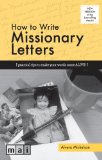 This $5 ebook is written to help you write better letters to your supporters. While new technologies provide many different ways to communicate, the missionary letter remains the basic tool for most missionaries. Your letter must attract and keep the readers’ attention and communicate your ministry clearly and effectively. This short 64-page book explains the principles behind authoring a letter that will be read and lead to the prayer and financial support you seek.
This $5 ebook is written to help you write better letters to your supporters. While new technologies provide many different ways to communicate, the missionary letter remains the basic tool for most missionaries. Your letter must attract and keep the readers’ attention and communicate your ministry clearly and effectively. This short 64-page book explains the principles behind authoring a letter that will be read and lead to the prayer and financial support you seek.
books
Cross-Cultural Partnerships
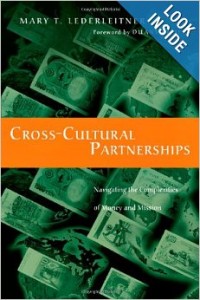 Unprecedented numbers of Christian missions agencies, churches, organizations, and individuals are seeking to broaden and deepen their work through partnerships with non-Western nationals. Cross-cultural partnerships have many advantages but they can give rise to a perplexing number of challenges. While definitely not a new trend, this emphasis on multicultural teamwork is a rapidly growing one, and there is sufficient history to demonstrate some of the challenges in these cross-cultural partnerships. One of the greatest areas of conflict revolves around finances. In this book, Mary Lederleitner, a cross-cultural consultant at Wycliffe, tackles some of the common issues regarding finances in partnerships.
Unprecedented numbers of Christian missions agencies, churches, organizations, and individuals are seeking to broaden and deepen their work through partnerships with non-Western nationals. Cross-cultural partnerships have many advantages but they can give rise to a perplexing number of challenges. While definitely not a new trend, this emphasis on multicultural teamwork is a rapidly growing one, and there is sufficient history to demonstrate some of the challenges in these cross-cultural partnerships. One of the greatest areas of conflict revolves around finances. In this book, Mary Lederleitner, a cross-cultural consultant at Wycliffe, tackles some of the common issues regarding finances in partnerships.
Money is a key element of mission work. Without funding, missions agencies would cease to exist. The proper use of money (and the sometimes laborious accounting for that money) is essential in stewardship and compliance. The author discusses many aspects involving money and how each of them are perceived in different cultures. For instance, she addresses the differences that Western and non-Western partners have in relation to ideas about collectivism, lending, and hoarding.
The author speaks to some of the negative attitudes that Westerners can bring to partnership, such as negative attribution of motives, quick judgments, and paternalism. She mentions how distance, lack of contact, and cultural nuances can cause us to assume the worst in the other person. She presents proactive ways to change these attitudes
Accountability is key in handling ministry funds to prevent fraud, to ensure proper allocation of donor restricted funds, and to enable proper record keeping. Too often, the financial reports from non-Western partners are inadequate or absent. Additionally, the constant requests for reports from western colleagues can damage relationships as it undermines trust, which is key in any partnership. The author gives examples of ways to contextualize accountability and fraud prevention to work together to ensure proper use of funds without damaging the relationship.
This book would be beneficial to missionaries, managers at multi-national missions organizations, financial staff supporting national partners, and church leaders or others seeking to fund the work of nationals. Many readers with missions experience will resonate with the examples given as they think of their own similar experiences. For a broader view of cross cultural issues, read Cross-Cultural Connections by Duane Elmer.
Cross-Cultural Training Books
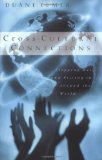
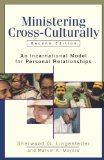
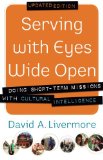 Are you looking for a book to help you prepare for cross cultural service or to read together with your team? Here are three great choices. Cross Cultural Connections by Duane Elmer uses his now classic “Cultural Adjustment Map” and provide discussion questions at the end of each chapter. Ministering Cross-Culturally by Sherwood Lingenfelter is a shorter read and provides an assessment to help you determine your differences in key areas. Serving with Eyes Wide Open by David Livermore discusses Cultural Intelligence , or CQ, and how short-term missions teams can better prepare for ministry.
Are you looking for a book to help you prepare for cross cultural service or to read together with your team? Here are three great choices. Cross Cultural Connections by Duane Elmer uses his now classic “Cultural Adjustment Map” and provide discussion questions at the end of each chapter. Ministering Cross-Culturally by Sherwood Lingenfelter is a shorter read and provides an assessment to help you determine your differences in key areas. Serving with Eyes Wide Open by David Livermore discusses Cultural Intelligence , or CQ, and how short-term missions teams can better prepare for ministry.
Medical Handbooks
 Do you live or travel a long distance from modern medical facilities? It pays to be prepared for emergencies. Besides normal first aid training, you should consider advanced training. Some wilderness training courses are designed teach advanced subjects when it is assumed that there is no one else you could contact to assist you. Here are some links to download PDF medical manuals. You never know when you’ll need this information and while PDF files aren’t ideal in some emergencies, they are free, portable, and helpful.
Do you live or travel a long distance from modern medical facilities? It pays to be prepared for emergencies. Besides normal first aid training, you should consider advanced training. Some wilderness training courses are designed teach advanced subjects when it is assumed that there is no one else you could contact to assist you. Here are some links to download PDF medical manuals. You never know when you’ll need this information and while PDF files aren’t ideal in some emergencies, they are free, portable, and helpful.
A Higher Purpose: Manual for Tentmakers
 Are you looking for a way to train national Christians to plant churches and live as missionary tent-makers? Many Filipinos travel overseas for opportunities to work and are also sharing their faith and serving as tent-makers. How does one person do this? Is it possible for a regular low-level worker to even keep himself spiritually nourished, much less share his faith with others? A Higher Purpose For Your Overseas Job was written for Filipino believers moving overseas. It incorporates spiritual growth, evangelism, missions, and church planting in one easy to read manual. Download the PDF. Buy a printed copy.
Are you looking for a way to train national Christians to plant churches and live as missionary tent-makers? Many Filipinos travel overseas for opportunities to work and are also sharing their faith and serving as tent-makers. How does one person do this? Is it possible for a regular low-level worker to even keep himself spiritually nourished, much less share his faith with others? A Higher Purpose For Your Overseas Job was written for Filipino believers moving overseas. It incorporates spiritual growth, evangelism, missions, and church planting in one easy to read manual. Download the PDF. Buy a printed copy.
Getting Things Done
 Do you want to be more productive with your time? Do you want to stay on top of everything for which you are responsible? David Allen’s book Getting Things Done: The Art of Stress-Free Productivity is about how to do just that. In somewhat of a contrast to Steven Covey’s top-down approach of time management, Allen presents a bottom-up model for “getting things done” or “GTD,” as it is often called. His model is comprised of five phases: collecting, processing, organizing, reviewing, and doing. The basic idea is that everything is gathered in some form outside your head and collected in a paper inbox or email inbox. Then each item is evaluated to determine what, if anything needs to be done. Tasks that need to be done at a certain time are placed on the calendar. Tasks that may be accomplished in less than two minutes are done immediately and the remaining tasks are placed on a “next action” list, grouped by the context in which they must be accomplished – i.e. at work, at home, at a telephone, at a computer, etc… Each week, the calendar, the projects, and the “next action” lists are reviewed to make sure everything is on track. The GTD system may be implemented by high tech users with smartphones, PDAs, computers, and other gadgets, by low tech users with paper and pencil, or by a combination of both high and low tech tools. The principles remain the same.
Do you want to be more productive with your time? Do you want to stay on top of everything for which you are responsible? David Allen’s book Getting Things Done: The Art of Stress-Free Productivity is about how to do just that. In somewhat of a contrast to Steven Covey’s top-down approach of time management, Allen presents a bottom-up model for “getting things done” or “GTD,” as it is often called. His model is comprised of five phases: collecting, processing, organizing, reviewing, and doing. The basic idea is that everything is gathered in some form outside your head and collected in a paper inbox or email inbox. Then each item is evaluated to determine what, if anything needs to be done. Tasks that need to be done at a certain time are placed on the calendar. Tasks that may be accomplished in less than two minutes are done immediately and the remaining tasks are placed on a “next action” list, grouped by the context in which they must be accomplished – i.e. at work, at home, at a telephone, at a computer, etc… Each week, the calendar, the projects, and the “next action” lists are reviewed to make sure everything is on track. The GTD system may be implemented by high tech users with smartphones, PDAs, computers, and other gadgets, by low tech users with paper and pencil, or by a combination of both high and low tech tools. The principles remain the same.
Key Concepts:
- Write everything down
- Enter tasks and projects in a system that you really trust
- Use do-able language on your next action list (Verb, Subject, Object – “Call Bill about Training”)
- Organize reference materials
- Review your lists
Related Links:
- Wikipedia Article
- Amazon Page
- Google Book Page
- Chapter 1: The Art of Getting Things Done
- Chapter 6: Processing: Getting “In” to Empty
- Video of David Allen at Google
- Tickler File
- Mind mapping

Making Disciples of Oral Learners
 Making Disciples of Oral Learners is a short book that gives a basic yet comprehensive overview of the reasons and methods related to ministry among oral learners. By the term oral learners they mean “those people who learn best and whose lives are most likely to be transformed when instruction comes in oral forms.” The book concludes with a glossary that will help the reader understand key terms related to orality. Click here to download the PDF version of the book.
Making Disciples of Oral Learners is a short book that gives a basic yet comprehensive overview of the reasons and methods related to ministry among oral learners. By the term oral learners they mean “those people who learn best and whose lives are most likely to be transformed when instruction comes in oral forms.” The book concludes with a glossary that will help the reader understand key terms related to orality. Click here to download the PDF version of the book.
Great Commission Companies
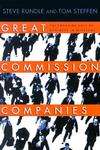 I recently read Great Commission Companies: The Emerging Role of Business in Missions by Steve Rundle and Tom Steffen. Both authors serve on faculty at Biola University in California and have studied for-profits companies established with a missions purpose.
I recently read Great Commission Companies: The Emerging Role of Business in Missions by Steve Rundle and Tom Steffen. Both authors serve on faculty at Biola University in California and have studied for-profits companies established with a missions purpose.
The authors begin by describing how many Christians view vocational callings, an idea that businessmen are at the bottom of the ladder, and then come teachers and doctors, then pastors, and finally missionaries. This vocational hierarchy implies that the truly spiritual businessmen should abandon his secular employment and seek to serve God as a missionary or in some other church related role. The authors then set out to refute this paradigm by showing how God is using people from the business world to fulfill the Great Commission.
The authors define a Great Commission Company (or GCC) as “a socially responsible, income-producing business managed by kingdom professionals and created for the specific purpose glorifying God and promoting the growth and multiplication of local churches in the least-evangelized and least-developed parts of the world.” They then explain how business touches the whole world and often kingdom professionals can work among those who would not respond to a traditional missionary.
They classify GCCs as either facilitative, meaning that their main purpose is to support the ministry of others, and pioneering, being those GCCs involved in direct ministry. The second part of the book gives in-depth descriptions of five GCCs with the personal testimonies of the entrepreneurs and the challenges of the GCC, both from a business and ministry perspective.
I found this book to be a good introduction into the field commonly called ‘Business as Mission’ or BAM. The examples cited are a reminder that both business and ministry are difficult work as the ministries described are not stories of success on the scale we might expect. There is a lot of energy and thought in the direction of BAM in recent years. Perhaps this is next big thing in missions. The biggest question may be how BAMers will relate to traditional missionaries, churches, and missions agencies. While I see validity in the model of missionary activity put forth in this book, I also think that we need to think more about this and blend it with a more entry-level “working/living overseas” approach. I have to ask myself if the current model of missionaries supported financially by those in the home country will continue to be the dominant model of missionary activity throughout the next century.
The World is Flat
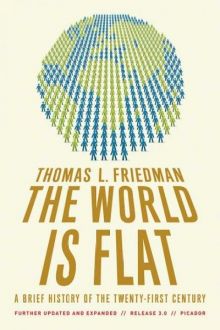 In The World is Flat, Thomas Friedman, foreign affairs columnist for the New York Times, describes how the world has become a more equal playing field to many of its people and the resulting implications. Friedman begins his book by giving examples of global out-sourcing and the extent of global communication. He explains how new technology has resulted in creating a level playing field, or a “flat world,” for workers in other countries. He then seeks to explain how this has happened. Friedman lists and describes the ten “flatteners” that created the flat world. These include the fall of the Berlin wall and the rise of Microsoft Windows, the release of Netscape, work flow software, open-sourcing, outsourcing, offshoring, supply-chaining, insourcing, in-forming, and the “steroids,” – those things that made made the other “flatteners” more digital, mobile, personal, and virtual.
In The World is Flat, Thomas Friedman, foreign affairs columnist for the New York Times, describes how the world has become a more equal playing field to many of its people and the resulting implications. Friedman begins his book by giving examples of global out-sourcing and the extent of global communication. He explains how new technology has resulted in creating a level playing field, or a “flat world,” for workers in other countries. He then seeks to explain how this has happened. Friedman lists and describes the ten “flatteners” that created the flat world. These include the fall of the Berlin wall and the rise of Microsoft Windows, the release of Netscape, work flow software, open-sourcing, outsourcing, offshoring, supply-chaining, insourcing, in-forming, and the “steroids,” – those things that made made the other “flatteners” more digital, mobile, personal, and virtual.
The next section looks at how the US should react to a flat world. He encourages American workers to work harder and develop more knowledge and creative jobs that cannot be as easily outsourced. He outlines recommendations for educational, economic, and political changes that the US should make to remain a world leader. Friedman then turns his focus to the underdeveloped world and the Islamic world. He looks at the reasons that opportunities are limited in these nations and what could be done so that the individuals in these nations can enter the flat world. He looks at global politics and causes of terrorism.
Citing numerous examples and drawing from his vast wealth of personal interviews, Friedman illustrates his points with skill. He uses examples from corporations, both large and small, governments, and non-governmental organizations to explain how the flat world principles work. This book explains what we see happening in the world around us and show how recent breakthroughs fit together like puzzle pieces to form our modern world. He explains why certain things that may seem insignificant are actually major shifts that have shaped the last fifteen years. Applications may be made in political, vocational, religious, and organizational facets of life.
DAWN Research Handbook
DAWN (Discipling a Whole Nation) has a well written handbook for their field researchers. It explains the philosophy behind DAWN’s methods and their research and then gives a practical how-to guide to field research. This 130 page guide is good training material for anyone involved in church or missions research. It includes sample questionnaires for churches and denominations. Download the handbook. Additional resources from DAWN.